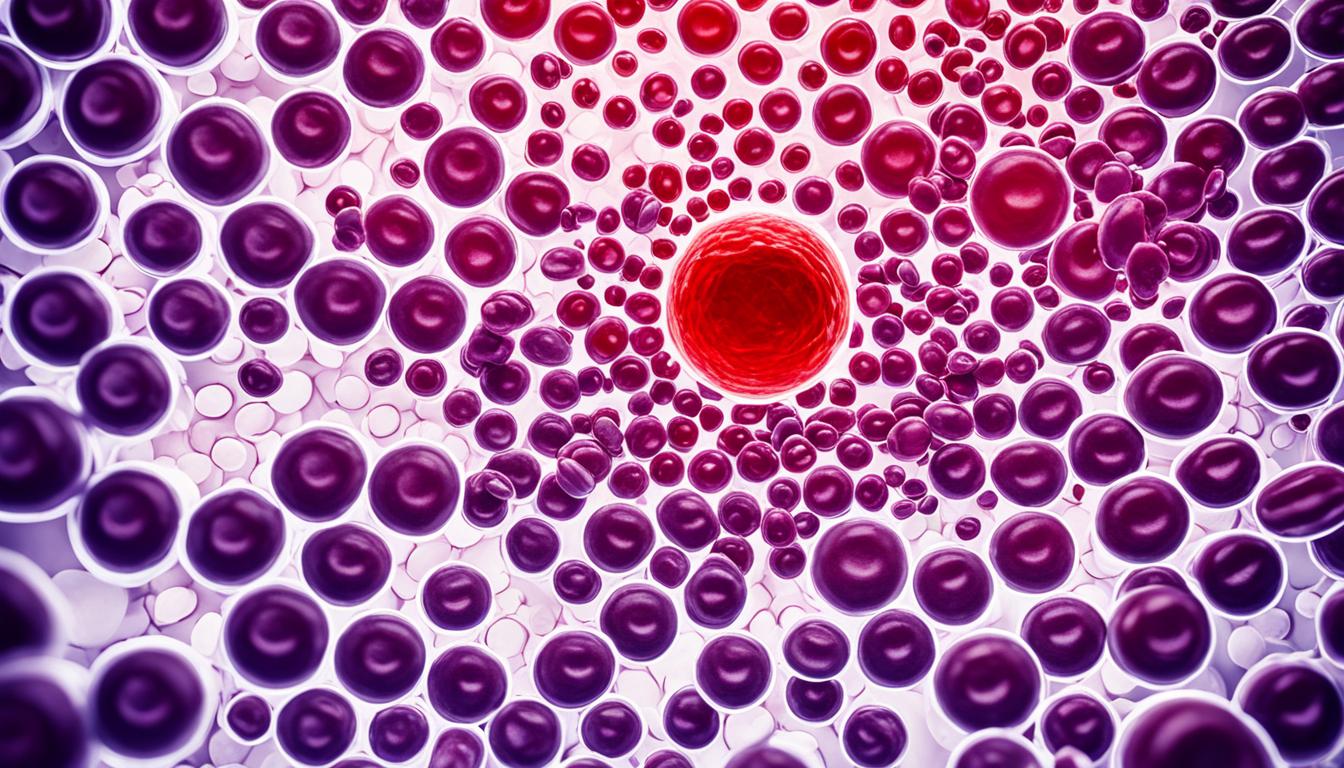Sickle cell anemia, also known as sickle cell disease, affects many people worldwide. It is more common in those of African, Mediterranean, Middle Eastern, and South Asian backgrounds. This condition is caused by a gene mutation, leading to the production of an abnormal form of hemoglobin, hemoglobin S.
This change in hemoglobin makes red blood cells shape differently. They become stiff and sticky. This can block blood flow and cause health problems.
People with sickle cell anemia often face crises of pain, tire easily, and are more prone to infections. These issues can affect their daily lives. Yet, there are many ways to help manage the condition and avoid problems.
Key Takeaways:
- Sickle cell anemia is a hereditary blood disorder characterized by the production of abnormal hemoglobin.
- It affects millions of people worldwide, particularly those of African, Mediterranean, Middle Eastern, and South Asian descent.
- Common symptoms include recurrent pain crises, fatigue, anemia, and increased susceptibility to infections.
- Treatment options focus on managing symptoms and preventing complications, including pain management, hydration, blood transfusions, and the use of medications like hydroxyurea.
- In severe cases, bone marrow or stem cell transplants can provide a potential cure for sickle cell anemia.
Understanding the Causes and Symptoms of Sickle Cell Anemia
Sickle cell anemia is a genetic disorder affecting the blood. It results from a mutation in the HBB gene. This mutation causes the production of an abnormal hemoglobin called hemoglobin S. Due to this, red blood cells are deformed and turn into a sickle shape. This change blocks blood flow, causing health problems.
The main symptom is recurrent pain crises. These are also known as vaso-occlusive crises. They happen when the deformed red blood cells block blood flow. The pain crises can affect various body parts, and their intensity and duration can differ.
People with sickle cell anemia may also have anemia. This means they have a low red blood cell count. It can cause tiredness, weakness, and not enough oxygen getting to tissues and organs. They are also more likely to get infections since their damaged red blood cells can’t fight off germs well.
This disease also makes people vulnerable to serious issues like acute chest syndrome and stroke. Acute chest syndrome happens when blood vessels in the lungs are blocked. This blockage can lead to chest pain, trouble breathing, and damage to the lungs. A stroke occurs when blood vessels in the brain are too small. This can cause problems with movement, vision, or speaking.
It’s vital to educate people and healthcare professionals about sickle cell anemia. This knowledge is key for early detection and proper treatment. When health experts understand the genetic problem and watch for signs like pain crises, anemia, and infection risk, they can offer better care.
Diagnosis and Treatment Options for Sickle Cell Anemia
Sickle cell anemia is a hereditary blood condition. It needs careful diagnosis and the right treatment options. This helps control symptoms and make life better. Specific tests, like blood tests, are used for diagnosis. So are hemoglobin screenings and ultrasounds. These tests are done to check for stroke risk and find the sickle cell genes.
Diagnosing Sickle Cell Anemia
Diagnosing sickle cell anemia starts with a blood test. This test looks for the S type of hemoglobin. It’s done as part of newborn screening. But, it’s also used for older children and adults.
Other tests like ultrasounds and genetic counseling may be recommended, too. Ultrasounds can check stroke risk by looking at blood flow in the brain. Genetic counseling tells families about sickle cell genes, helping them make informed choices.
Treatment Options
Treating sickle cell anemia aims to ease symptoms, prevent issues, and improve health. The kind of treatment depends on how bad the condition is and what the person needs. Common treatments include:
- Hydroxyurea: This medicine boosts fetal hemoglobin levels. Fetal hemoglobin doesn’t sickle easily. So, it can lessen the number and pain of crises in people with this condition.
- Blood Transfusions: If oxygen delivery is low or there’s a risk of stroke, blood transfusions help. They improve how well blood carries oxygen and can lower the chances of problems. Severe cases might need regular transfusions.
- Stem Cell Transplant: A stem cell transplant could cure severe sickle cell anemia. Healthy stem cells from a donor replace the bad bone marrow. It’s a hard procedure that needs careful medical care.
- Gene Therapies: New gene therapies might be another way to treat sickle cell anemia. These therapies try to fix the gene problem causing the illness. Even though this area of treatment is new, it’s promising for the future.
The choice of treatment depends on different things. This includes how bad the disease is and the patient’s age. A healthcare provider needs to carefully consider these factors to choose the best action plan.
Diagnosing sickle cell anemia is crucial because it guides the treatment. Options for treatment include managing symptoms, preventing issues, and finding possible cures through transplants or new gene therapies. Effective diagnosis and treatment are key for better quality of life. They help reduce pain crises and complications for those with sickle cell anemia.
Conclusion
Sickle cell anemia is a genetic disorder that affects many people worldwide. It’s important to know its causes and symptoms for accurate diagnosis. Effective management is key.
Various treatment options help manage symptoms and prevent complications. They aim to better the quality of life for those with sickle cell anemia.
Hope for future treatments and even cures is alive thanks to ongoing research. Gene therapies are improving. The support from genetic counseling is crucial. It helps families to understand and make good choices for care.
It’s vital to keep researching and educating about sickle cell anemia. Ongoing healthcare improvements are also necessary. By working on these things, we can help those with this condition have a better life. We aim for a future where everyone gets improved care and a better quality of life.

